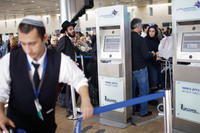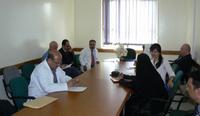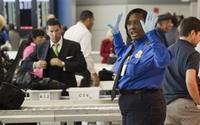-
Cement prison for old radioactive waste
The cold war may be over, but its radioactive legacy is not; between 1950 and 1990, nuclear weapons materials production and processing at several federal facilities generated billions of gallons of water contaminated with radioactive byproducts; researchers at Idaho National Laboratory test an inexpensive method to sequester strontium-90 where it lies. The researchers can coax underground microbes to form calcite, a white mineral form of calcium carbonate and the main ingredient in cement. Calcite should be able to trap strontium-90 until long after it has decayed into harmless zirconium
-
-
Napolitano says Israeli-style security is not suitable for U.S.

DHS secretary Janet Napolitano is in Israel on a visit; during her private briefing with Israeli officials at Ben-Gurion Airport, they discussed cargo screening and how to stop non-metallic explosives, such as those used in the recent plots, from getting onto a plane; Napolitano was also briefed on other airport security measures used in Israel; Napolitano said, however, that what is effective in Israel, a nation of 7.3 million, would not necessarily work for 310 million Americans; Ben-Gurion is Israel’s only major international airport; the United States has 450 such facilities; about eleven million people pass through Israeli airports each year, while seventy times that many passengers go through American airports each year
-
-
New technology speeds cleanup of nuclear contaminated sites
Hundreds of millions of dollars are spent on cleanup of some major sites contaminated by radioactivity, primarily from the historic production of nuclear weapons during and after the Second World War; Oregon State University researchers have invented a new type of radiation detection and measurement device that will be particularly useful for cleanup of sites with radioactive contamination, making the process faster, more accurate and less expensive
-
-
Privacy pants for airport security
“Privacy pants” would allow airport security personnel to do their job while keeping passengers’ privacy and dignity intact
-
-
TSA to pay special attention to insulated beverage containers
TSA announced terrorists might use insulated beverage containers to conceal explosives, so in the coming days, passengers flying within and to the United States may notice additional security measures related to insulated beverage containers
-
-
Questions about TSA's approach to security technology
The massive push to improve airport security in the United States after the attacks of 9/11 led to a gold rush in technology contracts for an industry that mushroomed almost overnight; since it was founded in 2001, the TSA has spent roughly $14 billion in more than 20,900 transactions with dozens of contractors; in addition to beefing up the fleets of X-ray machines and traditional security systems at airports nationwide, about $8 billion also paid for ambitious new technologies; critics question whether TSA was too eager to look for technological solutions to basic security problem, and willing to write checks for unproven products
-
-
Yemen buys cargo screeners
Yemen is deploying Z Backscatter Vans from Billerica, Massachusetts-based American Science and Engineering Inc. to screen cargo and vehicles for explosives and contraband
-
-
Geologists develop way to monitor covert nuclear tests in the Middle East
Not only is it difficult to identify exactly where an explosion takes place, but it is especially challenging to differentiate the seismic waves generated by nuclear explosions from those generated by earthquakes, volcanic activity, and mine collapses; geologists develop improved seismic model for monitoring nuclear explosions in Middle East
-
-
WikiLeaks: Yemen radioactive stocks "easy al-Qaeda target"

Yemeni official told U.S. diplomats that the lone sentry standing watch at Yemen’s national atomic energy commission (NAEC) storage facility had been removed from his post, and that the facility’s only closed circuit TV security camera had broken down six months previously and was never fixed; “Very little now stands between the bad guys and Yemen’s nuclear material,” the official warned, in a cable dated 9 January this year sent from the Sana’a embassy to the CIA, the FBI, and the department of homeland security; when told of the Yemeni nuclear storage problem, Matthew Bunn, a Harvard University nuclear terrorism expert, said: “Holy cow. That’s a big source. If dispersed by terrorists it could make a very nasty dirty bomb capable of contaminating a wide area”
-
-
Hope for terahertz: laser operates at higher temperatures than thought possible
Terahertz rays — radiation between microwaves and infrared rays on the electromagnetic spectrum — are a promising means of detecting explosives, but they have proven hard to generate cost effectively. So far, solid-state lasers — the cheap, miniature type of laser found in CD players — have been unable to produce terahertz rays unless they are super-cooled, which makes them impractical for mass deployment; now a group of researchers report a solid-state terahertz laser that operates at nearly twice the temperature that putative proportionality would have predicted
-
-
Medical isotopes no longer require weapons-grade uranium
Highly enriched uranium (HEU) is used in nuclear weapons, but it is also used to make the radioisotopes that are injected in tiny quantities into people to diagnose and treat disease; indeed, making medical isotopes is a time-honored excuse for enriching uranium, if you want to build nuclear weapons but do not want to admit you are doing so (this is the cover Iran is using for its bomb-oriented enrichment program); South Africa’s Pelindaba reactor is now producing medical treatment-oriented molybdenum-99 (Mo-99) made from low-enriched uranium
-
-
ICx Technologies: comprehensive, layered approach to security
At the recent ASIS exhibition and seminar, Homeland Security Newswire took the time to walk through the ICx Technologies booth and speak to some of their subject matter experts; CommandSpace® & ThreatSense™, solutions which provide a comprehensive, layered approach to perimeter security and chemical, biological, radiological and nuclear security for critical facilities, respectively, were on display
-
-
A woman wearing only black underwear gets hour-long airport security search
An Oklahoma woman tried to avoid being subjected to an enhanced pat-down at the Oklahoma City airport by showing up for the flight wearing only her underwear; the fact that she was wearing black knickers and a black bra did not make a difference, though: after traces of nitrate were found on her body, she was given an enhanced search, which made her miss her flight to Phoenix
-
-
Harvard law students sue TSA over pat-downs, full-body scanning
Two Harvard law students sue TSA, seeking to rein in use of full-body scans and pat-downs at airports; this is at least the sixth suit filed against the TSA since the agency put the enhanced screening procedures into widespread use following the so-called underwear bomber’s unsuccessful attempt to blow up a plane last Christmas with explosives hidden beneath his clothes; the pat-downs, which include “prodding and lifting of genitals and buttocks,” is so intrusive that, “if done non-consensually, would amount to sexual assault in most jurisdictions,” the Harvard students’ complaint says
-
-
Third lawsuit filed over TSA airport screening

A Colorado attorney has asked a federal judge to order the Transportation Security Administration (TSA) to abandon its airport screening procedures for U.S. citizens; the suit claims that the patdowns the plaintiff, his two daughters, ages 9 and 15, and a family friend were subjected to in San Diego were “disgusting, unconscionable, sexual in nature” and in violation of the Constitution’s protections against unreasonable searches; nationally, at least two other lawsuits have been filed over the TSA’s new procedures; public opinion appears to be shifting against TSA’s “enhanced patdowns,” even as support for full-body scanning appears to remains high
-
More headlines
The long view
Keeping the Lights on with Nuclear Waste: Radiochemistry Transforms Nuclear Waste into Strategic Materials
How UNLV radiochemistry is pioneering the future of energy in the Southwest by salvaging strategic materials from nuclear dumps –and making it safe.
Model Predicts Long-Term Effects of Nuclear Waste on Underground Disposal Systems
The simulations matched results from an underground lab experiment in Switzerland, suggesting modeling could be used to validate the safety of nuclear disposal sites.
